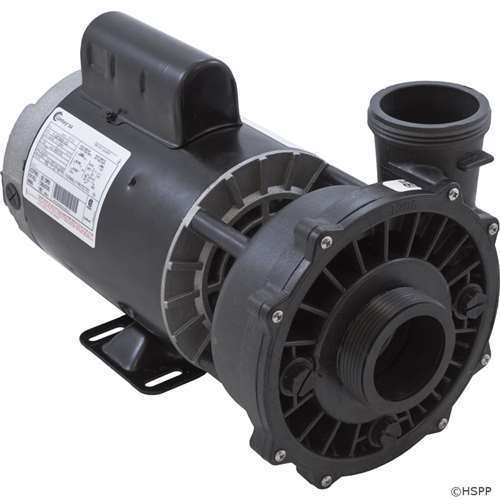|
...
Need Help?
Call
800-876-7647










 |
 |
|
Spa Pump Troubleshooting

Warning - Please read this section
first !
This section is presented for the do-it-yourselfer who
needs some help either troubleshooting or repairing their own hot tub spa. Here we are
assuming that if you have chosen to work on your own unit, you have a basic knowledge of
electricity.
Please remember that water and electricity DO NOT MIX. If
you are not capable of performing a repair yourself, please contact a local spa
professional or a licensed electrician in your area.
Also realize that the wiring and equipment described herein
represents the "average" spa equipment pack. Your unit may vary significantly
from the components described below. If you are in doubt as to how to properly
troubleshoot or repair your specific unit, please contact a local spa professional or a
licensed electrician in your area.
Use any of the information contained herein
AT YOUR OWN RISK. We will not be held liable for any injuries that may result from the
troubleshooting or installation of any electrical components in your hot tub spa unit.
|
| Pump Servicing - Various Problems If you have a problem related to the wet end of the pump, this is
the section to be in. Please note that these are generic instructions for the
"average" pump. Your unit may vary.
- The impellers must be matched to the motors. Do not mix them up.
1-1/2hp impellers must only be used with 1 -1/2hp "full rate" motors (those that
have a service factor of 1.0) and 1 hp impellers with 1 hp "full rate motors"
Mixing them up will result in improper motor amperage loads and subsequent premature
failure of the motors.
If your motor has a service factor (SF on the data plate) of other
than 1.0, it is an up rated motor. In this case, match the impeller based on amp rating.
To be sure you have matched them correctly, once the impeller is
installed and the pump is running under full load, take an amperage reading while on high speed. The reading you get
should be within 10% of the high speed amp rating on
the data plate. If it measures higher, the motor will
prematurely burn up. If it measures lower, you simply are not getting as much out of that
motor as it is designed to deliver.
- If a motor seems to run fine but is not putting out the water
like it should, remove the faceplate and check the blades of the impeller. If debris has
gone through the pump, some of it may be stuck in the blades which will reduce the
effectiveness of the pump. Also, while the impeller is accessible, check the tightness of
the impeller on the shaft. To hold the motor shaft, remove the cap at the corded of the
motor such that the metal shaft is exposed. The motor shaft has a large screwdriver slot
in it. Insert a screwdriver with one hand and while preventing the shaft from moving,
check to see that the impeller does not turn with the other hand. WARNING: USE A RAG AT THE IMPELLER. THE IMPELLER MAY HAVE EDGES THAT ARE
VERY SHARP!! You will not need a tool to hold the impeller
to check tightness. Hand tight is all it needs. A stripped shaft will be rather obvious.
- When changing an impeller, it is best to examine the
motor shaft and remove any build up of rust that might have occurred during the life of
the pump. If not removed, the rust may prevent proper tightening of the motor shaft
resulting in rubbing, leakage, or stripping of the impeller threads inside the impeller.
The impeller should glide on easily and turn onto the shaft easily until the threads
bottom out with a very solid stop. If it turns hard, remove the impeller and check the
motor shaft threads for debris from the previous impeller or dents that would prevent
their mating with the plastic impeller threads. If damaged, correct the threads with a
thin metal file or a shaft thread file designed just for this purpose. (A motor repair
place may be able to help you obtain this. A thread file makes shaft repair very quick and
accurate with little effort.)
- When replacing a pump seal, wet the impeller shaft a
little with water to make sliding it on easier. WARNING: DO NOT LUBRICATE WITH ANYTHING
BUT WATER. The rubber doughnut on the seal will displace the water and a secure seat
on the shaft will result. Other lubrication will allow the seal to spin on the shaft once
the pump is turned on. This will melt the impeller shaft with the friction it creates,
thus causing a new leak. Once applied, the stainless steel side with the rubber doughnut
should be against the impeller blades while the carbon ring side should face the shaft end
of the impeller. The rubber cup on the ceramic 1/2 of the seal can also be
lubricated with water in the same fashion in order to be pressed into the housing. The
white flat side of the ceramic should be facing the impeller after installation in the
housing. (The side of the ceramic facing the rubber cup has a groove in it.) It is
important that the seal be pressed squarely down into the housing. If crooked, a leak will
often result.
NOTE: The Waterway and Martec seal set parts have reversed
location, that is, the spring portion is in the housing and the ceramic portion goes on
the impeller. Still use water to easily seat the ceramic, but you may want to apply a thin
film of silicone sealant (not to be confused with silicone lubricant) to the steel cup
before pressing it into the housing. BE CAREFUL NOT TO GET SILICONE ON THE BLACK
SURFACE THAT PRESSES AGAINST THE CERAMIC RING. The contamination could cause premature
failure of the seal.
- When mounting a housing to the motor, be sure to center
the motor shaft inside the ceramic. Tighten the motor bolts carefully and once all are
tight, check once more to make sure the shaft is centered. If too close to the ceramic,
the impeller will be more difficult to mount and will often rub enough to cause damage to
the impeller and/or motor. It may even rub enough to prevent the motor from running at
all. As a "rule of thumb’, always check the motor shaft for free movement after
applying the impeller to the shaft and after assembling the face of the pump.
- Be sure to re-install the eye seal to the impeller
before applying the faceplate. Without it, the pump will not move as much water, and will
cavitate causing it to run noisily. Be sure to mount it with the wide side of the seal
facing the pump faceplate.
Remember:
Use any of the information contained herein
AT YOUR OWN RISK. We will not be held liable for any injuries that may result from the
troubleshooting or installation of any electrical components in your hot tub spa unit.
|

Check
out our complete selection of Spa Parts now
|
|

